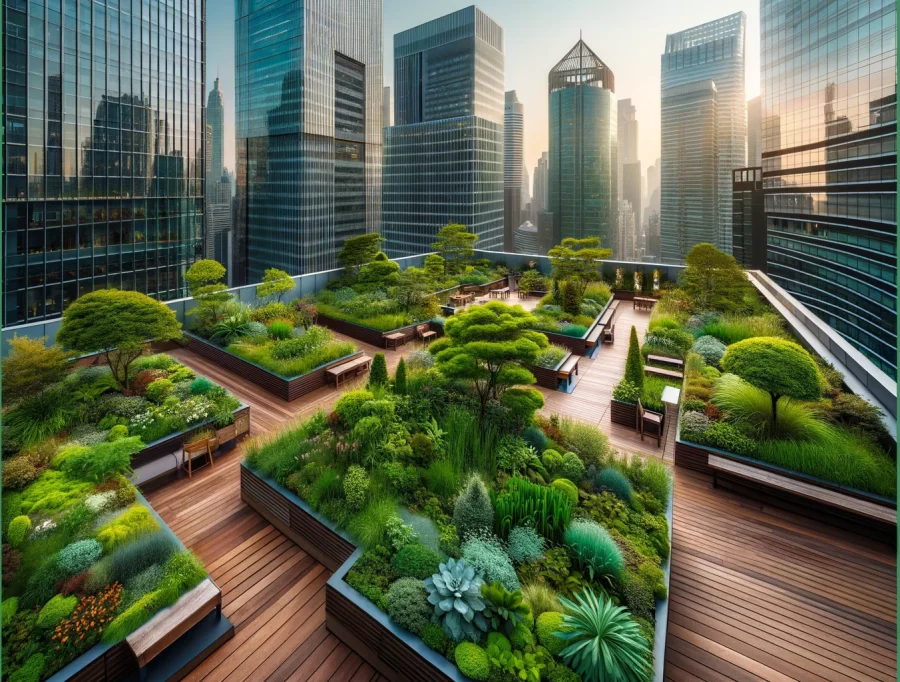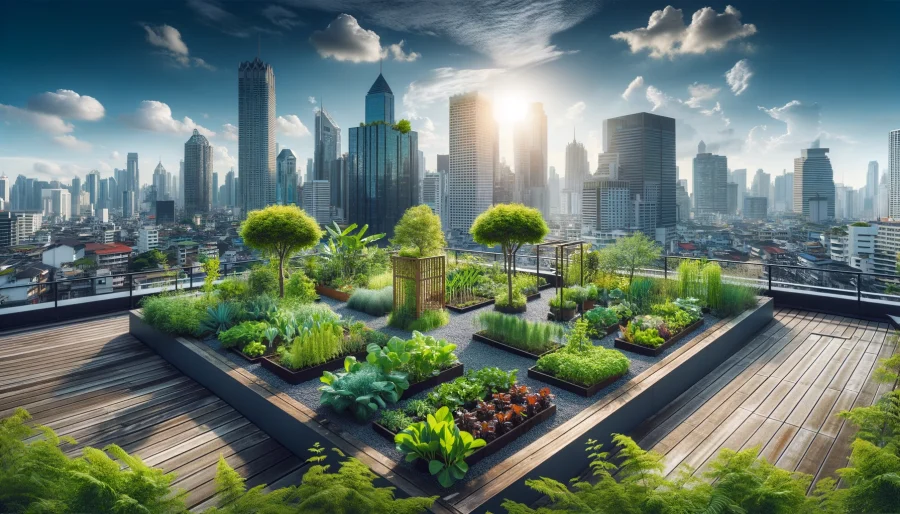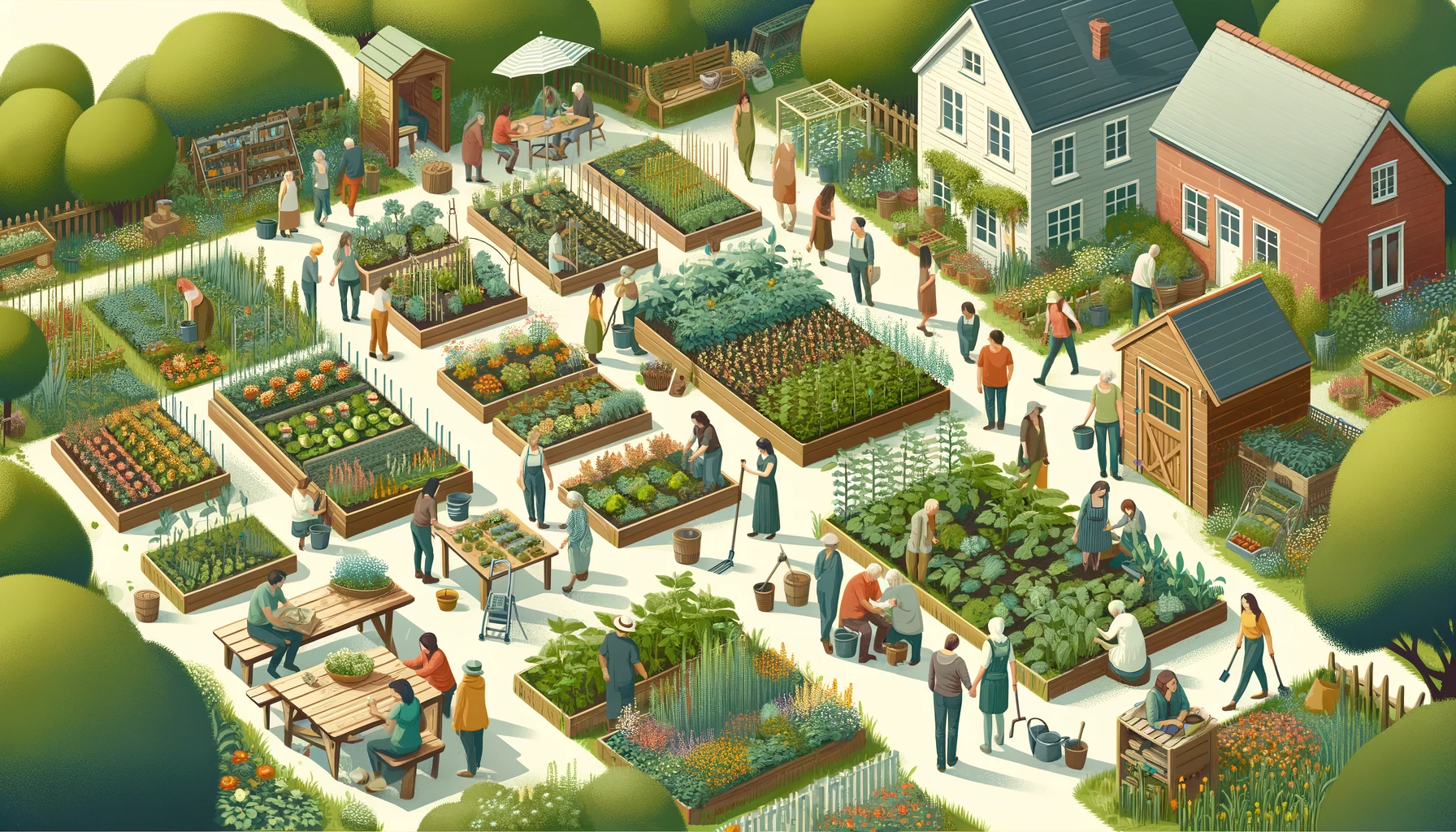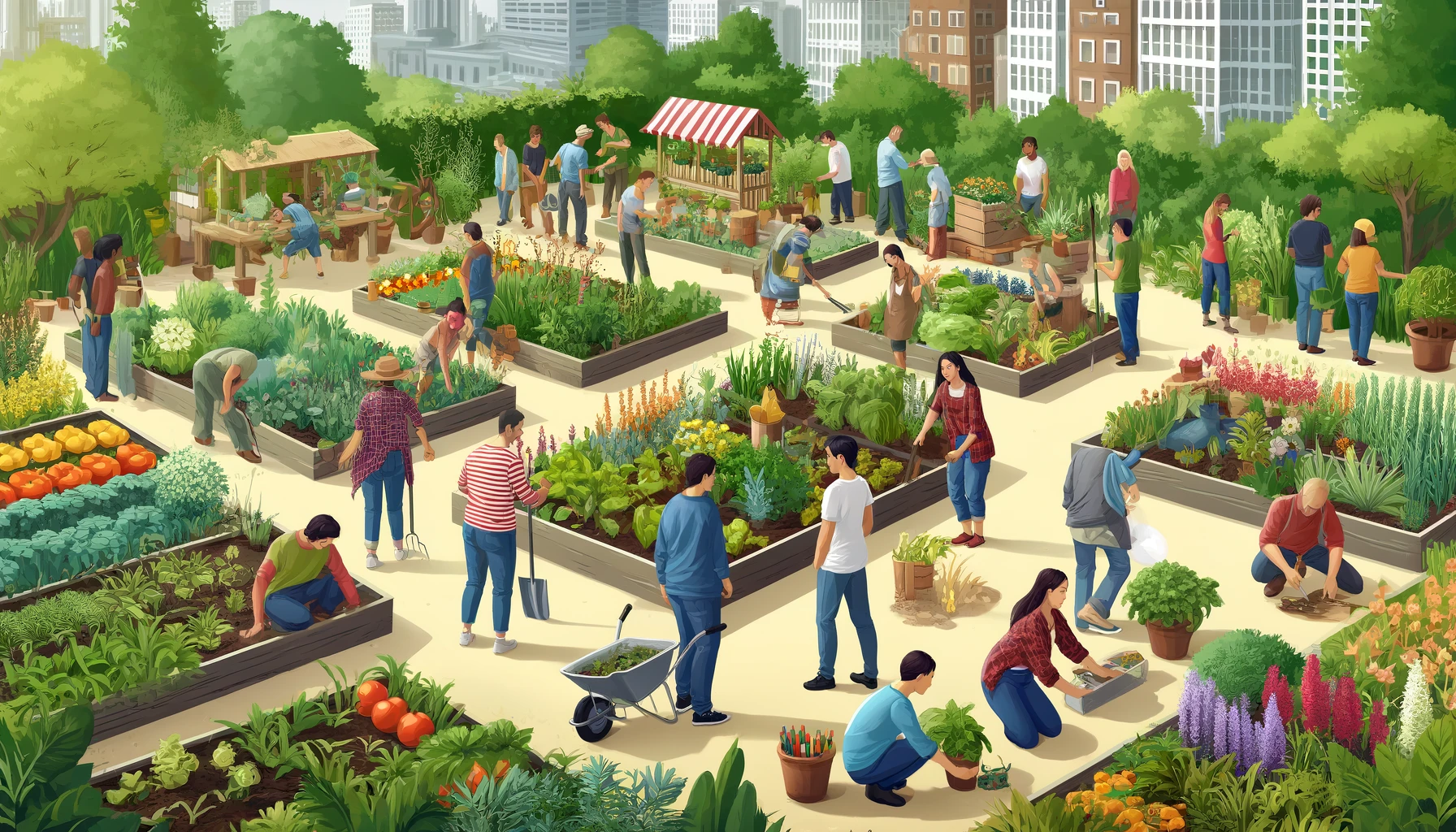We use affiliate links. If you purchase something using one of these links, we may receive compensation or commission.

Why start rooftop gardening? Discover how it transforms urban spaces into green oases. Learn the benefits, challenges, and tips for starting your rooftop garden.
Why Start Rooftop Gardening?
Key Takeaways:
- Rooftop gardening is the cultivation of plants on building rooftops, offering environmental benefits, fresh produce, and enhanced urban aesthetics.
- It’s suitable for various plants and requires careful planning for structural support, irrigation, and plant selection.
Have you ever wondered what rooftop gardening is and why you would want to start rooftop gardening?
It’s a creative and eco-friendly way to bring nature to urban areas by turning unused rooftops into vibrant gardens.
Not only does it beautify the cityscape, but it also provides fresh produce and helps the environment.
Let’s dive into the world of rooftop gardening and explore its wonders.
Why Start Rooftop Gardening?

Rooftop gardening involves cultivating plants and vegetation on the rooftops of buildings, transforming urban environments into green spaces.
Rooftop gardens hold significant importance in urban settings as they not only add aesthetic value but also provide numerous benefits for the environment and the community.
Green roofs help reduce the urban heat island effect, lower energy consumption by insulating buildings, improve air quality by capturing pollutants, and mitigate stormwater runoff by absorbing rainfall.
In dense urban areas with limited green spaces, rooftop gardens offer a unique opportunity to enhance biodiversity, provide habitat for pollinators, and create tranquil sanctuaries amidst the hustle and bustle of city life.
In this article, we will explore the different types of plants suitable for rooftop gardening and provide tips on how to set up your own rooftop garden successfully.
Why Is Rooftop Gardening Becoming Popular?
Rooftop gardening is gaining popularity due to its ability to reduce energy consumption, its historical significance dating back to ancient Mesopotamia and the Hanging Gardens of Babylon.
One of the key factors contributing to the rise of rooftop gardening is its positive impact on energy efficiency.
Creating green spaces on urban rooftops, helps lower indoor temperatures in buildings, reducing the need for excessive air conditioning, thus conserving energy.
This practice not only benefits the environment but also aids in cutting down electricity bills for building owners.
Looking back at history, rooftop gardening traces its origins to ancient civilizations like Mesopotamia, where the renowned Hanging Gardens of Babylon stood as a testament to mankind’s early architectural and horticultural ingenuity.
What Are The Benefits Of Rooftop Gardening?
Rooftop gardening offers numerous benefits such as combating the urban heat island effect, reducing environmental impact, and promoting urban agriculture.
Here is a list of 10 rooftop garden benefits:
- Maximizes Space: Utilizes unused rooftop areas for greenery and agriculture.
- Improves Air Quality: Plants filter pollutants and produce oxygen, leading to cleaner air.
- Reduces Energy Costs: Provides insulation, lowering heating and cooling expenses.
- Mitigates Urban Heat Island Effect: Absorbs sunlight and cools the surrounding environment.
- Enhances Biodiversity: Supports a variety of plants and wildlife, promoting ecological balance.
- Provides Fresh Produce: Offers a source of locally-grown fruits, vegetables, and herbs.
- Reduces Stormwater Runoff: Absorbs rainwater, decreasing the burden on drainage systems.
- Improves Mental Health: Offers a peaceful, green space for relaxation and stress reduction.
- Increases Property Value: Adds aesthetic appeal and functionality, boosting real estate value.
- Promotes Community Engagement: Encourages social interaction and collective gardening efforts.
One of the key advantages of rooftop gardening is its significant role in combating the urban heat island effect, which refers to the phenomenon where urban areas experience higher temperatures than surrounding rural areas due to human activities and limited green spaces. By utilizing rooftop gardens, buildings can reduce heat absorption, thus cooling the surrounding environment and helping to mitigate the heat island effect.
Plus this, rooftop gardening also contributes to reducing environmental impact by absorbing carbon dioxide, releasing oxygen, and providing habitat for birds and insects. This not only improves air quality but also enhances biodiversity in urban settings.
Rooftop gardens play a vital role in promoting urban agriculture by providing space for growing fruits, vegetables, and herbs. This not only encourages local food production but also creates opportunities for community engagement and education on sustainable farming practices.
Maximizes Space
Rooftop gardening maximizes available space, enabling innovative solutions like building-integrated agriculture, as seen in cities like Singapore.
By utilizing rooftops for green spaces, urban areas can transform previously unused areas into thriving agricultural zones. Not only does rooftop gardening provide a sustainable food source, but it also helps reduce the urban heat island effect by absorbing sunlight rather than reflecting it.
Cities such as Singapore have embraced the concept of rooftop gardens, creating lush oases atop skyscrapers and residential buildings. These green spaces not only enhance the visual appeal of the city but also contribute to biodiversity and local food production.
Improves Air Quality
Rooftop gardening contributes to improved air quality by introducing vegetation, green roofs, and enhancing biodiversity in urban areas.
Vegetation on rooftops helps in absorbing carbon dioxide and releasing oxygen, reducing air pollutants and greenhouse gases in the environment. Green roofs act as natural insulators, regulating indoor temperatures and decreasing the urban heat island effect.
The diverse plant species in rooftop gardens attract pollinators like bees and butterflies, supporting local ecosystems and promoting biodiversity. This green infrastructure also helps in mitigating stormwater runoff, reducing flooding risks, and filtering pollutants from rainwater before it enters water bodies.
Reduces Energy Costs
Rooftop gardening helps in lowering energy costs by providing insulation, improving energy efficiency, and reducing overall energy consumption.
When rooftop gardens are implemented, the plants and soil act as a natural barrier, helping to regulate indoor temperatures and reduce the need for heating or cooling systems, which in turn decreases energy consumption. The greenery on rooftops can absorb sunlight, reducing the energy consumption required to cool buildings. By harnessing rainwater, rooftop gardens also aid in further energy cost reduction by minimizing the load on drainage systems during heavy rainfall.
Provides Fresh Produce
Rooftop gardening allows for fresh produce cultivation through rooftop farming initiatives, supporting local food production and promoting access to fresh, locally sourced food.
With the growing trend of urban agriculture, rooftop gardening provides a sustainable solution for communities to produce their food locally. By utilizing underutilized rooftop spaces, individuals can grow a variety of fruits, vegetables, and herbs, reducing the need for long-distance transportation of produce.
This not only contributes to a more eco-friendly food system but also ensures that consumers have access to nutrient-rich, freshly harvested crops that are not only delicious but also packed with essential vitamins and minerals.
What Are The Challenges Of Rooftop Gardening?
Despite its benefits, rooftop gardening poses challenges such as structural issues, cost efficiency concerns, and maintenance requirements.
Rooftop gardening faces structural limitations due to the weight-bearing capacity of buildings. Not all structures are designed to support the additional load of soil, plants, and water. This necessitates a thorough structural assessment before initiating a rooftop garden to ensure safety and stability.
Considering cost efficiency is crucial as setting up a rooftop garden can involve expenses for materials, labor, waterproofing, and irrigation systems. Balancing initial investments with long-term benefits becomes essential in making a financially sound decision.
Regular maintenance is vital to ensure the health and growth of plants in rooftop gardens. From watering and fertilizing to pest control and pruning, consistent care is needed to avoid issues such as plant diseases and nutrient deficiencies.
Structural Limitations
Structural limitations present a significant challenge in rooftop gardening, including weight restrictions and structural issues that impact garden design and implementation.
One of the primary concerns with rooftop gardening is the weight restrictions imposed by the rooftop structures. Many rooftops have specific weight limits that must be adhered to, restricting the types of plants and the amount of soil that can be used. This requires careful consideration during the garden planning phase to ensure the structural integrity of the building is not compromised.
Additionally, structural issues such as weak spots or inadequate support can present serious obstacles in establishing a successful rooftop garden. Building owners or gardeners may need to enlist the help of structural engineers to assess the rooftop’s capacity and implement any necessary reinforcements to support the garden’s weight.
Weight Limitations
Weight limitations in rooftop gardening require careful consideration due to exposure to elements, potential stormwater runoff concerns, and the impact on plant health.
Regarding exposure to elements, the weight of soil, containers, and plant material can put stress on the structure of the building, leading to potential safety hazards. The accumulation of stormwater runoff can overwhelm drainage systems, causing leaks and water damage. As a result, plant health may be compromised due to insufficient drainage, nutrient leaching, and increased risk of root rot. Therefore, it is essential to choose lightweight materials, utilize proper drainage systems, and regularly monitor the weight distribution to maintain a healthy rooftop garden.
Exposure To Elements
Rooftop gardens face challenges from exposure to elements, requiring consideration of different green roof types and debunking common myths surrounding rooftop gardening.
Green roof systems come in various types such as extensive, semi-intensive, and intensive, each offering unique benefits based on factors like maintenance needs and plant variety. Extensive green roofs, with their shallow soil depth, are low-maintenance and ideal for drought-resistant plants, while semi-intensive and intensive roofs allow for a wider plant selection but require more upkeep.
Regarding myths about green roofs, one common misconception is that they are prone to leaks and structural damage. Proper installation by professionals using quality materials ensures that green roofs are structurally sound and effectively waterproofed, making them a viable option for sustainable urban landscaping.
What Are The Types Of Plants Suitable For Rooftop Gardening?
Various types of plants are suitable for rooftop gardening, including succulents and cacti, herbs and vegetables, as well as flowers and ornamental plants.
Regarding succulents and cacti, these are excellent choices for rooftop gardens due to their ability to thrive in dry and arid conditions while requiring minimal maintenance. They come in various shapes and sizes, adding a unique touch to the green space.
Herbs and vegetables, on the other hand, are not only functional but also aesthetically pleasing. Growing fresh herbs like basil, mint, and parsley can enhance the rooftop ambiance and provide a sustainable source of culinary ingredients.
Succulents and Cacti
Succulents and cacti offer aesthetic benefits in rooftop gardens, especially in semi-intensive green roof setups that prioritize visual appeal and low maintenance requirements.
These plants are perfect for rooftop gardening due to their ability to thrive in arid conditions and their unique shapes and colors that add a touch of elegance to any outdoor space. In a semi-intensive green roof system, which involves a mix of native plants and selected species, succulents and cacti stand out for their adaptability and resilience.
Their fleshy leaves and stems store water, reducing the need for frequent watering and making them ideal for eco-friendly green roofs. Their minimal care needs make them a popular choice for urban gardeners looking to create striking rooftop landscapes without excessive maintenance.
Herbs and Vegetables
Herbs and vegetables contribute to rooftop gardens by providing fresh produce and creating recreational spaces, while dispelling common myths surrounding the cultivation of edible plants on rooftops.
Having an array of herbs like basil, mint, and cilantro, along with vegetables such as tomatoes, peppers, and lettuce, not only adds a delightful touch to rooftop gardens but also ensures a bountiful supply of organic, home-grown ingredients for your culinary adventures.
The presence of these green gems transforms a mundane rooftop into a serene oasis, ideal for relaxation, social gatherings, or simply enjoying a peaceful moment amidst nature.
Contrary to popular misconceptions, modern rooftop gardening techniques address concerns like structural load, water drainage, and suitable plant varieties, making growing edibles on rooftops a viable and sustainable option.
Flowers and Ornamental Plants
Flowers and ornamental plants enhance rooftop gardens aesthetically, contributing to urban development and beautification projects, as exemplified in cities like New York City.
In bustling urban areas such as New York City, rooftop gardens provide a refreshing oasis amidst the concrete jungle. The colorful blooms and lush greenery not only add visual appeal but also play a crucial role in mitigating the urban heat island effect by providing natural cooling.
These green spaces not only enhance the quality of life for residents but also promote biodiversity and support pollinators, contributing to a more sustainable urban environment.
The presence of flowers and ornamental plants in rooftop gardens can serve as educational tools, inspiring city dwellers to connect with nature and cultivate a love for green spaces in the heart of the city.
How To Set Up A Rooftop Garden?
Establishing a rooftop garden involves several steps including consultation with building management, assessing design considerations, and selecting appropriate plants for specific climates like those in San Francisco or Trent University.
Before beginning the process, it is crucial to engage in fruitful discussions with the building management to acquire necessary approvals and meet any regulations related to setting up a rooftop garden. This step ensures smooth cooperation and avoids potential conflicts.
Design considerations play a pivotal role in the success of a rooftop garden, encompassing factors such as weight limitations, irrigation systems, sunlight exposure, and wind patterns. A thorough evaluation of the space must be conducted to determine the optimal layout and plant placement. By tailoring plant choices to the local climate, such as the foggy coastal conditions in San Francisco or the cooler temperatures of Trent University, the garden can thrive sustainably and enhance the surrounding environment with beauty and functionality.
Check With Your Building Management
Before starting a rooftop garden, it is crucial to consult with building management, involving urban planners and green space experts for guidance, as exemplified by companies like Gotham Greens.
When embarking on a rooftop gardening project, seeking advice from building management ensures that all regulations and structural considerations are taken into account. Urban planners play a vital role in designing the layout and optimizing the space for maximum greenery while maintaining structural integrity.
Green space experts, such as those at Gotham Greens, bring valuable insights into plant selection, irrigation systems, and sustainable practices. Their expertise can help elevate the rooftop garden from a concept to a thriving urban oasis.
Consider Structural Requirements
Understanding the structural requirements for a rooftop garden is essential, considering both benefits and limitations, and conducting thorough research to ensure successful implementation.
Rooftop gardens have become increasingly popular due to their numerous advantages, such as promoting urban green spaces, reducing energy consumption, improving air quality, and providing relaxation areas in bustling cities.
It is crucial to assess the load-bearing capacity, waterproofing, drainage systems, and sunlight exposure of the rooftop before initiating the garden setup. Potential limitations like structural integrity, access to water sources, and building regulations must also be evaluated to avoid any setbacks during the project.
Research plays a vital role in the planning and execution process, helping to select suitable plants, irrigation methods, and maintenance strategies to maximize the garden’s sustainability and longevity.
Choose The Right Containers
Selecting the appropriate containers for plants in a rooftop garden is crucial for vegetation health, maintenance efficiency, and aesthetic appeal, as seen in urban settings like New York City.
In a bustling metropolis such as New York City, rooftop gardens present unique challenges and opportunities. The choice of containers greatly impacts not only the health of the plants but also the ease of maintenance. A well-thought-out selection can ensure proper drainage to prevent waterlogging, sufficient space for root growth, and protection from strong winds. The aesthetic aspect plays a vital role in enhancing the overall appeal of the rooftop garden, making it a serene oasis amidst the urban jungle.
Plan For Irrigation And Drainage
Developing a comprehensive plan for irrigation and drainage systems in rooftop gardening is crucial for successful design considerations, ensuring benefits like lush greenery and efficient water management.
Regarding rooftop gardening, the layout and structure of the irrigation and drainage systems play a pivotal role in the overall success of the garden. Proper planning involves determining the right type of irrigation method, such as drip irrigation or soaker hoses, to ensure that water is delivered efficiently to the plants. Strategic placement of drainage outlets and channels is essential to prevent waterlogging and potential damage to the rooftop structure.
By paying attention to these design considerations, rooftop gardeners can enjoy numerous benefits. Efficient irrigation systems help in conserving water and reducing water waste, making the garden environmentally friendly and sustainable. Adequate drainage systems protect the plants from root rot and water stagnation, ensuring healthy growth and vibrant foliage.
Ultimately, the result of meticulous planning and implementation of irrigation and drainage systems is a lush green oasis atop a concrete jungle. The harmonious balance between water supply and drainage allows plants to thrive, creating a serene and visually appealing rooftop garden that enhances the overall aesthetic and ecological value of the space.
Select The Appropriate Plants
Choosing the right plants for a rooftop garden involves considerations regarding structural issues, cost efficiency, and dispelling common myths to ensure a successful and sustainable green space.
Structural concerns are paramount when selecting plants for rooftop gardens, as the weight of the plants, soil, and water must be carefully evaluated to prevent any potential damage to the building. Cost-effective choices play a crucial role in this process, as opting for native or drought-resistant plants can reduce maintenance costs and water consumption.
There are several myths surrounding rooftop gardens, such as the belief that only hardy succulents can survive. With proper planning, a diverse range of plants can thrive in this environment, contributing to a flourishing green oasis above the city skyline.
Why Start Rooftop Gardening FAQs
Q. What is rooftop gardening?
Rooftop gardening is the practice of growing plants, vegetables, and herbs on the roof of a building instead of traditional ground-level gardening. It utilizes the available space on roofs to create green and sustainable areas for gardening.
Q. Why is rooftop gardening becoming popular?
Rooftop gardening is becoming popular due to its many benefits. It allows people in urban areas to have access to fresh produce, improves air quality, reduces energy costs, and helps to combat climate change.
Q. What are the benefits of rooftop gardening?
Some of the benefits of rooftop gardening include providing food security, reducing the urban heat island effect, improving stormwater management, creating a habitat for wildlife, and promoting a sense of community.
Q. Is rooftop gardening suitable for all types of buildings?
No, rooftop gardening is not suitable for all types of buildings. It requires a flat or slightly sloped roof with proper structural support to hold the weight of the garden, access to sunlight, and a water source.
Q. What types of plants can be grown in a rooftop garden?
A variety of plants can be grown in a rooftop garden, including vegetables, fruits, herbs, flowers, and even small trees. It is important to choose plants that can tolerate the rooftop environment, such as wind, sunlight, and fluctuating temperatures.
Q. How can I start a rooftop garden?
To start a rooftop garden, you need to assess your rooftop’s structural capacity, access to sunlight and water, and any building codes or permits required. Then, you can choose the appropriate containers, soil, and plants, and start gardening. It is also helpful to seek advice from experienced rooftop gardeners or professionals.
Why Start Rooftop Gardening Conclusion
Rooftop gardening is not just about adding greenery to urban landscapes; it’s about creating ecosystems where there was none, providing fresh produce in food deserts, and building community in unexpected places.
This innovative approach to gardening turns underutilized spaces into productive and beautiful retreats, offering numerous benefits to urban dwellers and the environment alike.
As we explore the various aspects of rooftop gardening, it becomes clear how this practice is reshaping our cities for the better.
Environmental Impact
- Combats Urban Heat Island Effect: Rooftop gardens help reduce the temperature in urban areas, making cities more livable during hot summer months.
- Improves Air Quality: Plants on rooftops filter pollutants and carbon dioxide out of the air, contributing to healthier urban environments.
Social Benefits
- Encourages Community Engagement: Rooftop gardens can become communal spaces where residents gather, share, and learn about sustainable living.
- Provides Educational Opportunities: They serve as living classrooms for people of all ages to learn about botany, ecology, and sustainability.
Economic Advantages
- Reduces Energy Costs: By insulating buildings, rooftop gardens lower heating and cooling costs, saving money for homeowners and businesses.
- Increases Property Value: Buildings with rooftop gardens are often more desirable, leading to increased property values and rental prices.
Challenges and Considerations
- Structural Limitations: Ensuring buildings can support the additional weight is crucial for safety and longevity.
- Maintenance and Upkeep: Regular care is essential to keep the garden thriving, including watering, weeding, and managing pests.
By addressing these aspects, rooftop gardening can be a viable and beneficial addition to urban areas, offering a slice of nature in the concrete jungle.
Read more: Rooftop Gardening for Beginners Easy Tips and Tricks



